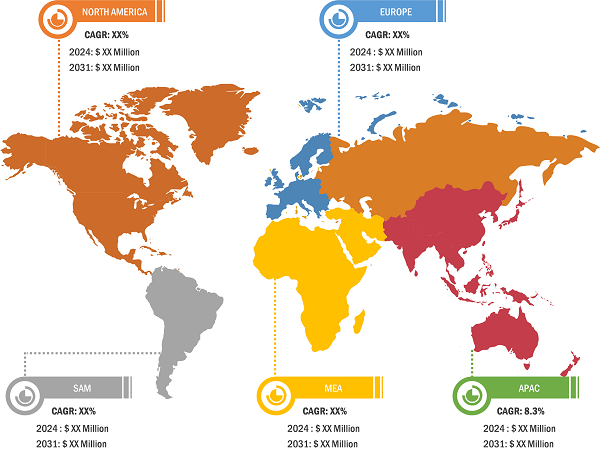Growth of 5G and Next?Gen Wireless Networks Boosts Semi Directional Antenna Market Growth
According to our latest study titled “Semi Directional Antenna Market Forecast to 2031 – Global and Regional Share, Trend, and Growth Opportunity Analysis – by Product Type, Technology, and Industry,” the market was valued at US$ 430.38 million in 2024 and is projected to reach US$ 678.06 million by 2031; it is estimated to register a CAGR of 6.8% from 2025 to 2031. The report includes growth prospects in light of current semi directional Antenna market trends and factors influencing market growth.
The expansion of 5G and next-generation wireless networks is the largest factor underpinning the semi-directional antenna market. As 5G networks are rolled out globally, telco operators and infrastructure providers need antenna systems to meet the requirements of balancing coverage, capacity, and deployment challenges. Semi-directional antennas are beneficial in this case because they have a more focused antenna radiation pattern, as well as distance and extension of signal strength advantages over omnidirectional antennas. Still, they are not as narrow and focused as a fully directional type.
Semi Directional Antenna Market – by Region, 2024 and 2031
Semi Directional Antenna Market Size and Forecast (2021-2031), Global and Regional Share, Trend, and Growth Opportunity Analysis Report Coverage: By Product Type (Patch, Panel, Sector, and Others), Technology (5G, 4G/LTE, Wi-Fi, Bluetooth, GPS/GNSS, and Others), and Industry (Telecommunications, Consumer Electronics, Mining, Aerospace and Defense, Industrial, Automotive and Transportation, and Others)
Semi Directional Antenna Market Size & Forecast to 2031
Download Free Sample
Source: The Insight Partners Analysis
5G networks operate on sub-6 GHz and mmWave frequencies, creating specific challenges because of their individual propagation characteristics. Higher frequency mmWave has increased signal attenuation, making coverage and line-of-sight connectivity more difficult. Semi-directional antennas help provide targeted coverage and improved gain, providing advantages over omnidirectional antennas that are especially useful in urban canyons, smart city deployments, and mid-range small-cell deployments. Additionally, beamforming and Massive MIMO technologies require antennas to spatially manage the signal, and semi-directional antennas can be used in configurations that effectively improve spectrum efficiency and the user experience. As carriers build more densified networks (including small cells, distributed antenna systems (DAS), and private 5G networks), semi-directional antennas become more essential for scalable, dependable, and more affordable connections. Therefore, this trend is likely to yield very healthy market growth over the next 10 years.
The semi directional antenna market analysis has been carried out by considering the following segments: product type, technology, and industry. Based on product type, the market is divided into patch, panel, sector, and others. Based on technology, the semi directional antenna market is classified into 5G, 4G/LTE, Wi-Fi, Bluetooth, GPS/GNSS, and others. By industry, the market is segmented into telecommunications, consumer electronics, mining, aerospace and defense, industrial, automotive and transportation, and others. The telecommunications segment held the largest semi directional antenna market share in 2024.
The geographic scope of the semi directional antenna market report is primarily segmented into North America (US, Canada, and Mexico), Europe (Russia, UK, Germany, France, Italy, and Rest of Europe), Asia Pacific (South Korea, China, India, Japan, Australia, and Rest of Asia Pacific), the Middle East & Africa (UAE, Saudi Arabia, South Africa, and Rest of Middle East & Africa), and South & Central America (Brazil, Argentina, and Rest of South & Central America). Asia Pacific accounted for the largest semi directional antenna market share in 2024. Asia Pacific (APAC) is, by far, the most significant component of the semi-directional antenna market due to the drastic digital transformation and significant updates to the telecommunication infrastructure. Currently, China, India, Japan, and South Korea are aggressively deploying 5G networks with government funding, smartphone adoption studies, and Generations 3 and 4 design initiatives across the spectrum. This unprecedented rollout requires that next-generation antenna solutions with high coverage and capacity upgrades yield the best ROI, such as supplemental semi-directional antennas for medium to high-density. Furthermore, APAC is the headquarters for a large telecommunications equipment manufacturing base, making the production of antenna systems and accessories significantly cheaper with competition to innovate more value into telecommunications in response to global telecommunication demand. Urbanization and smart city projects, as well as telecom interest in industrial automation, drive the demand for reliable wireless connectivity. Semi-directional antenna systems are the most reliable range versus directional antenna systems.
Panorama Antennas Ltd.; Sinclair Technologies Inc; Airgain, Inc.; Cisco Systems Inc; Ezurio; Huawei Technologies Co Ltd; PCTEL Inc.; 2J Antennas S.R.O.; Parsec Technologies; Quectel Wireless Solutions Co Ltd; Johanson Technology Incorporated; TE Connectivity Ltd; Pulse Electronics; Taoglas; Hubbell Inc; Mobile Mark, Inc; and Galtronics USA, Inc. are among the key players profiled in the semi directional antenna market report.
Contact Us
Phone: +1-646-491-9876
Email Id: sales@theinsightpartners.com